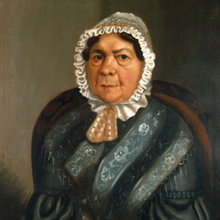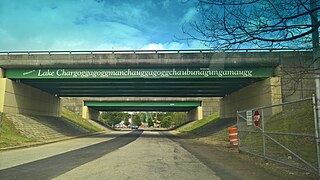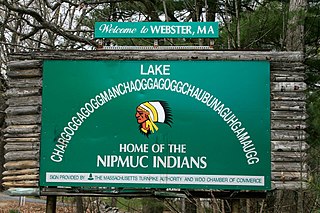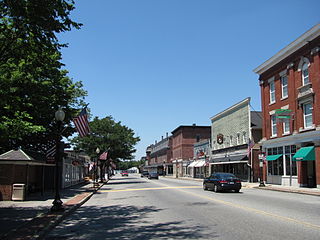
Grafton is a town in Worcester County, Massachusetts, United States. The population was 19,664 at the 2020 census. The town consists of the North Grafton, Grafton, and South Grafton geographic areas, each with a separate ZIP Code. Incorporated in 1735, the town is home to a Nipmuc village known as Hassanamisco Reservation, the Willard House and Clock Museum, Community Harvest Project, and the Tufts University Cummings School of Veterinary Medicine. Grafton operates the state's largest on-call fire department, with 74 members.

Webster is a town in Worcester County, Massachusetts. The population was 17,776 at the 2020 census.
Mount Wachusett is a mountain in Massachusetts. It straddles towns of Princeton and Westminster, in Worcester County. It is the highest point in Massachusetts east of the Connecticut River. The mountain is named after a Native American term meaning "near the mountain" or "mountain place". The mountain is a popular hiking and skiing destination. An automobile road, open spring to fall, ascends to the summit. Views from the top of Mount Wachusett include Mount Monadnock to the north, Mount Greylock to the west, southern Vermont to the northwest, and Boston to the east. The mountain is traversed by the 92 mi (148 km) Midstate Trail. It is also home to the Wachusett Mountain State Reservation.
State-recognized tribes in the United States are organizations that identify as Native American tribes or heritage groups that do not meet the criteria for federally recognized Indian tribes but have been recognized by a process established under assorted state government laws for varying purposes or by governor's executive orders. State recognition does not dictate whether or not they are recognized as Native American tribes by continually existing tribal nations.

The Nipmuc or Nipmuck people are an Indigenous people of the Northeastern Woodlands, who historically spoke an Eastern Algonquian language. Their historic territory Nippenet, "the freshwater pond place," is in central Massachusetts and nearby parts of Connecticut and Rhode Island.

Lake Chaubunagungamaug, also known as Webster Lake, is a lake in the town of Webster, Massachusetts. It is located near the Connecticut border and has a surface area of 1,442 acres. Since 1921, the lake has also been known by a much longer name having 45 letters comprising fourteen syllables: Lake Chargoggagoggmanchauggagoggchaubunagungamaugg. The lake has become famous beyond Central Massachusetts for having the longest name of any geographic feature in all of the United States.
The Brothertown Indians, located in Wisconsin, are a Native American tribe formed in the late 18th century from communities of so-called "praying Indians", descended from Christianized Pequot, Narragansett, Montauk, Tunxis, Niantic, and Mohegan (Algonquian-speaking) tribes of southern New England and eastern Long Island, New York. In the 1780s after the American Revolutionary War, they migrated from New England into New York state, where they accepted land from the Iroquois Oneida Nation in Oneida County.

The Hassanamisco Nipmuc Band is the original state acknowledged Nipmuc tribe as stated in the 1976 Dukakis Executive Order, Section I. The Hassanamisco Nipmuc Band own three and a half acres of reservation land in what is present day Grafton, Massachusetts. This group of indigenous people is native to Central Massachusetts, Northeastern Connecticut, and parts of Rhode Island.

The Webster/Dudley Band of Chaubunagungamaug Nipmuck Indians, also known as the Chaubunagungamaug, Chaubunagungamaug Nipmuck, Pegan or Dudley Indians, are a Native American tribe indigenous to the U.S. states of Massachusetts and Connecticut in the region of New England. They are an unrecognized tribe, meaning they are not federally recognized as a Native American tribe. They are also not state-recognized, unlike the Nipmuc Nation.

The Chaubunagungamaug Reservation refers to the small parcel of land located in the town of Thompson, Connecticut, close to the border with the town of Webster, Massachusetts and within the bounds of Lake Chaubunagungamaug to the east and the French River to the west. The reservation is used by the descendants of the Nipmuck Indians of the previous reservation, c. 1682–1869, that existed in the same area, who now identify as the Webster/Dudley Band of the Chaubunagungamaug Nipmuck. Together with the Hassanamisco Nipmuc, both have received state recognition under the Massachusetts Commission on Indian Affairs.
The MOWA Band of Choctaw Indians is a state-recognized tribe, located in southwest Alabama, with a population largely based in southern Washington County and some membership in northern Mobile County.
The Advisory Council on California Indian Policy (ACCIP) was created by an act of the United States Congress and signed by President George H. W. Bush on October 14, 1992. It provided for the creation of a special advisory council made up of eighteen members with the purpose of studying the unique problems that California Native Americans face in receiving federal acknowledgment. Additionally, they were given the task of studying the social and economic conditions of California natives, “characterized by, among other things, alcohol and substance abuse, critical health problems, family violence and child abuse, lack of educational and employment opportunities, and significant barriers to tribal economic development.” Under the provisions for the act, the Advisory Council was to make recommendations regarding California Indian policy to the Congress and the Departments of the Interior and of Health and Human Services.

Native American tribes in Massachusetts are the Native American tribes and their reservations that existed historically and those that still exist today in what is now the Commonwealth of Massachusetts. A Narragansett term for this region is Ninnimissinuok.

Ayer is a town in Middlesex County, Massachusetts, United States. Originally part of Groton, it was incorporated February 14, 1871, and became a major commercial railroad junction. The town was home to Camp Stevens, a training camp for Massachusetts volunteers during the American Civil War. Later, Fort Devens was established by the federal government to train New England soldiers for World War I. Fort Devens is a major influence on the area, although it is considerably smaller than when it was first closed in the mid-1990s. The town's population was 8,479 at the 2020 census.
Quinsigamond is a place in Massachusetts.
Cheryll Toney Holley is a First Nations American historian, genealogist, and museum director. She serves as the chief of the Hassanamisco Nipmuc, part of the Nipmuc Nation, a Massachusetts state-recognized tribe.

Zara Cisco Brough, also called Princess White Flower, served as the Chief of the Nipmuc Nation, a state-recognized tribe in Massachusetts, from 1962 until 1987. She is best known for her work to preserve Nipmuc heritage.
Black James was a Nipmuc constable and spiritual leader of the Chaubunagungamaug Nipmuck at the Chaubunagungamaug Reservation in colonial Massachusetts and Connecticut. Daniel Gookin appointed James to be a constable for the praying towns after he had become a Christian. In 1675, James signed a treaty agreeing not to assist King Philip, but may have supported him during King Philip's War. After the War, Black James deeded various parcels of land to settlers in Nipmuc country including at Quantisset and Maanexit in what is now eastern Connecticut near Rhode Island. His dying speech was recorded by Rev. Daniel Takawambait and later published and by 1686 a deed was signed by his heirs indicating that Black James was deceased, but another Indian used the name "Black James" until 1708.









